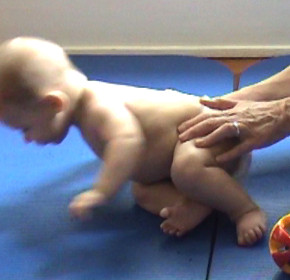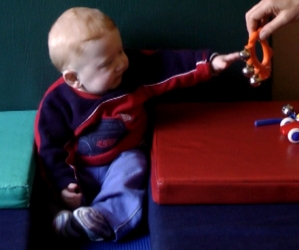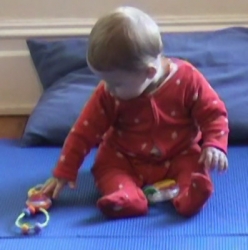Learning to sit has two aspects
1 The first aspect is the ability to maintain the head and trunk erect when supported in an upright position. Infants first learn to keep the head upright and steady when support is provided at the level of the axilla. Over time they progressively gain control over first the thoracic spine and then the lumbar spine.
This progressive development of extension of the spine can be seen when infants are supported in sitting at different levels.



In typically developing infants care givers adapt the support they provide the infant when lifting and carrying the infants, as well as when the infant sits on the caregivers lap.A small difference in the level of support can make a big difference to the infant's ability to sustain trunk extension.


2 The second aspect of learning to sit is learning to balance the trunk on the pelvis. Infants who are just learning to sit tend to move the trunk as a single unit balanced on a stable base formed by the buttocks and thighs. Balance is maintained as long as the center of mass remains fairly close to the center of the base of support. If the center of mass is displaced too far, the infant topples over with the head and trunk moving as a unit.

|
Saavedra, S. L., van Donkelaar, P., & Woollacott, M. H. (2012). Learning about gravity: segmental assessment of upright control as infants develop independent sitting. Journal of Neurophysiology, 108(8), 2215–2229. http://doi.org/10.1152/jn.01193.2011 |
The SfA TOMT assessment of sitting
Assessing an infant's ability to sit with manual support of the trunk provides insight into ability to stabilize the head when held in an upright position, as well as the ability to right the head when the trunk is tilted. These basic abilities are an essential prerequisite for the development of sitting.
Infants are often held in a sitting position on a caregivers lap - indeed lap sitting provides much of the infant's early experience with sitting. Caregivers will usually provide enough support to provide a safe environment for the infant.
If the infant can stabilize the head in space when the trunk is firmly supported, the next step is to provide support for the trunk which is less stable and requires some active trunk and arm support work to stay upright.
Importance of visual curiosity and desire to reach for toys
Lifting the head and keeping it erect in an upright position requires sustained effort, especially for an infant with weakness of the neck and trunk extensors. However, infants are usually willing to put in the effort if there is something really interesting to look at such as colorful toy or an animated face that invites social interaction.
Visual attention and sustained looking is first developed in supine on a flat support surface or a reclined seat. If you experience difficulties with getting the infant to visually engage then it may be necessary to first provide training opportunities that encourage looking and early reaching in supine or in a reclined seat.
Head control in supine: assessment and training
SfA TOMT assessment protocol
The TOMT assessment protocol provides the therapist with a comprehensive description of the progressive segmental levels of control of sitting (Rachmani et al 2015), starting with control of the head when supported upright to independent sitting with good control of reaching and transitions to prone and prone kneeling.
Identifying the segmental level of control of sitting allows the therapist to select training activities that will extend and expand the infant's ability to sit, maintain trunk and head stability and interact with the social and physical environment.
The assessment of sitting progresses through 3 basic levels
Sitting with trunk support: assessment of the infant's ability to keep the head erect and steady when supported around the trunk.


Sitting with pelvic support: assesses the ability of the infant to maintain the trunk erect and stable, as well as balance and control the the trunk when reaching, when provided with support around the pelvis.

Active independent sitting: assesses of the infant's ability to maintain balance and reach in all directions, as well as start to initiate transitions to prone and prone kneeling.


Planning your assessment
Your observation of the infant, as well as the information from caregivers, will usually provide the information about which segmental level of assessment is appropriate for the infant.
Start with activities that the infant can do successfully, and progressively add more difficult tasks.
If the infant has difficulty performing a task, adapt the task or change the environment to allow the infant to succeed. This will provide clues as to which aspect of the task is limiting the infant's ability to perform the task.
Assessment tasks at 3 levels
References
Rachwani, J., Santamaria, V., Saavedra, S. L., & Woollacott, M. H. (2015). The development of trunk control and its relation to reaching in infancy: a longitudinal study. Frontiers in Human Neuroscience, 9, 94. http://doi.org/10.3389/fnhum.2015.00094
Saavedra, S. L., van Donkelaar, P., & Woollacott, M. H. (2012). Learning about gravity: segmental assessment of upright control as infants develop independent sitting. Journal of Neurophysiology, 108(8), 2215–2229. http://doi.org/10.1152/jn.01193.2011